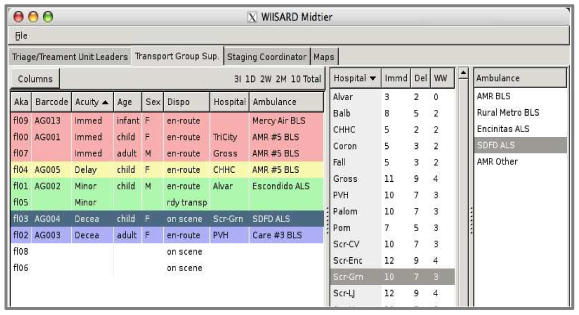Abstract
WIISARD utilizes wireless technology to improve the care of victims following a mass casualty disaster. The WIISARD Scene Manager device (WSM) is designed to enhance the collection and accessibility of real-time data on victims, ambulances and hospitals for disaster supervisors and managers. We recently deployed WSM during a large-scale disaster exercise. The WSM performed well logging and tracking victims and ambulances. Scene managers had access to data and utilized the WSM to coordinate patient care and disposition.
Disaster response to mass casualty incidents (MCIs) represents one of the greatest challenges to a community’s emergency response system. Rescuers, first responders, and incident managers often must provide care to overwhelming numbers of victims with limited resources, minimal information and inadequate communication tools. In particular, scene managers may have limited or inaccurate information on needs, numbers of victims and their injuries, and available resources.1 The Wireless Internet Information System for MedicAl Response to Disasters (WIISARD) project focuses on developing wireless and Internet technologies to enhance communication and real-time information availability for field responders and disaster scene managers. Key components of WIISARD include wireless victims tags; handheld provider devices with an electronic patient medical record (EMR); a WIISARD scene manager device (WSM) to track patients, injuries, and resources; wireless access points with ad hoc & mesh networking, tracking and data relay units; and integrated software operating concurrently through all layers to enhance situational awareness and accessibility to data information.

The WSM utilizes tablet PCs ruggedized for the field environment with a “client/server” model accessing a database which includes data from victim tags and EMRs, as well as from arriving ambulances and hospitals. The system adheres to the MVC (model/view/controller) design where the "models" come from the WIISARD server, "view" is the rendering of the models, and the "controller" provides a means of interaction with the models. The WSM software is specifically designed for scene/incident managers with role-specific user interfaces. The graphical user interfaces are designed to provide maximal access to data on patients and resources, while still being tailored to the specific tasks and duties of the scene manager. Triage area managers have access to all logged patients, their triage and decontamination status. Treatment area managers have access to lists of patients in their medical areas, their condition and vital signs. Transport managers can assign patients on to ambulances and hospitals for disposition.

We conducted an operational field test of the WSM as a part of the WIISARD system in a large scale MCI exercise involving a simulated terrorist chemical and blast injury disaster (Operation Fairgrounds, San Diego County, 11/2005).2 This large scale drill involved 100 actors simulating victims, over 20 responding law, fire and EMS agencies, and hundreds of first responders, scene managers, and incident commanders. Four WSM were deployed to the Metropolitan Medical Strike Team which provided initial field medical triage and patient care in combination with 10 handheld systems. Responders had little or no training with the device, but WIISARD staff were on scene to provide support. Overall, the WSM functioned well during the exercise. Ninety-seven victims were logged into the system by acuity and location. In addition, scene managers were able to perform their specific tasks utilizing the WSM including logging available ambulances and assigning patients to specific ambulances and destination hospitals. Responders using the system did report problems with screen visibility and font sizes. The tablet is a group work device. If one member of a group was temporarily disconnected from the network, data quality became an issue. Future versions will address these issues.
References
- 1.Chan TC, Killeen J, Griswold W, Lenert L. Information technology and emergency medical care during disasters. Acad Emerg Med. 2004;11:1229–36. doi: 10.1197/j.aem.2004.08.018. [DOI] [PubMed] [Google Scholar]
- 2. [(Accessed 3/12/2006)]. http//mmrs.fema.gov/news/terrorism/2005/oct/nter2005-11-21.aspx.


